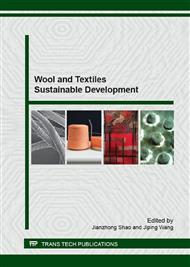[1]
LI Qingshan, Handbook of Discrimination of TextileFibre [M]. Beijing: China Textile Press, (2003).
Google Scholar
[2]
CHEN Weiguo, LI pengcheng, Lu Guang, et al. Near infrared spectroscopy topography tracing the cerebral hemodynamic changes in real time [J]. Acta Biophysica Sinica, 2000, 16(3): 613-617.
Google Scholar
[3]
JI Haiyan, YAN Yanlu. Quantitative analysis for barley components by partial least-square domestic near-infrared spectroscopy experimental instrument [J]. Analytical Chemistry, 1998, 26(5): 607-611.
Google Scholar
[4]
MCCAIG T.N. Extending the use of visible/near-Infrared reflectance spectrophotometers to measure of food and agriculture products[J]. Food Research International, 2002, 35(8): 731-736.
DOI: 10.1016/s0963-9969(02)00068-6
Google Scholar
[5]
LEI Meng, FENG xinlu. Study on the quantitative analysis of engine oil viscosity index by two-dimensional near-infrared spectroscopy [J]. Petroleum Processing and Petro Chemicals, 2009, 40(4): 61-65.
Google Scholar
[6]
CHAI Jinchao, JIN Shangzhong. Application of near infrared spectroscopy technology to qualitative inspection of textiles [J]. Journal of Textile Research, 2009, 30(4): 55-58.
Google Scholar
[7]
WU Guifang, HE Yong. Identification of varieties of textile fibers by using vis/near infrared spectroscopy technique [J]. Spectroscopy and Spectral Analysis, 2010, 30(2): 331-335.
Google Scholar
[8]
CHEN Bin, CUI Guang, JIN Shangzhong, et al. Application of near infrared spectra in rapid inspection of cotton contents [J]. Journal of Jiangsu University: Natural Science Edition, 2007, 28(3): 185-188.
Google Scholar
[9]
WAGN Dongmin, JIN Shangzhong, CHEN Huacai, et al. Quantitative analysis of cotton content in cotton terylene textile by near infrared technique [J]. Optics and Precision Engineering, 2008, 16(11): 2051-(2054).
Google Scholar
[10]
YAN Li, LIU Li. Test on fiber content of textile mixture materials with IR method [J]. Laser & Infrared, 2009, 39(6): 605-607.
Google Scholar
[11]
YAN Yanlu, ZHAO Longlian, Han Donghai, et al. Basic and Application of NIR Analysis [M]. Beijing: China Light Industry Press, (2005).
Google Scholar
[12]
LU Wanzhen. Modern near infrared Spectroscopy Analytical Technology [M]. Beijing: China Petrochemical Press, 2007: 13.
Google Scholar
[13]
YAN Yanlu. Analysis foundation and application of near infrared spectroscopy [M]. Beijing: China Light Industry Press, 2005: 8-9.
Google Scholar
[14]
ZHOU Ying, FU Xiaping, YING Yibin. The influence of humidity on near infrared spectrum detection [J]. Spectroscopy and Spectral Analysis, 2007, 27(11).
DOI: 10.13031/2013.23177
Google Scholar
[15]
ZHU Hongliang, YANG Meng, ZHANG Qi. Study on Rapid Quantitative Analysis Method of Cotton/spandex Blending Textiles [J]. China fiber inspection, 2011, 12(24): 54-58.
Google Scholar
[16]
LIANG Yizeng, XU Qingsong. Instrumental Analysis of Complex Systems-White, Gray and Black Analytical Systems and Their Multivariate Methods [M]. Beijing: Chemical Industry Press, 2012. 1.
Google Scholar


